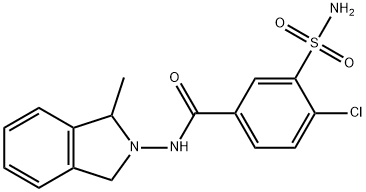
Zidapamide
- Product NameZidapamide
- CAS75820-08-5
- MFC16H16ClN3O3S
- MW365.83
- EINECS278-321-2
- MOL File75820-08-5.mol
Usage And Synthesis
5.6 ml of triethylamine are added to a solution of 5.0 g (0.018 m) of α-
methyl-α,α-dibromo-o-xylene and 2.38 g (0.018 m) of t-butylcarbazate in 15
ml of dimethylformamide heated to 50-60°C. After the addition, the mixture is
left stirring for 3 h at room temperature, the solution volume is then made up
to about 60 ml by diluting with H 2 O and the solution is left for a further hour
under stirring. The solid which separates is filtered off, washed with water and
dried to give 3.14 g (70%) of 1-methyl-N-(t-butyloxycarbonylamino)
isoindoline, melting point 143-145°C.
A suspension of 2.6 g (0.0104 m) of the 1-methyl-N-(t- butyloxycarbonylamino)isoindoline in 7 ml of concentrated HCl is kept stirring at room temperature for 1 h. The final solution is evaporated to dryness under vacuum by heating to 60-70°C to give a solid residue (1.97 g) which crystalises from EtOH+Et 2 O (1/1) to give 1.5 g (77.6%) of 1-methyl-2-amine isoindoline hydrochloride, melting point 140-145°C.
3.44 g (0.0 135 m) of 4-chloro-3-sulfamidobenzoic acid chloride are added to a solution of 2.5 g (0.0135 m) of 1-methyl-2-aminoisoindoline hydrochloride and 3.5 g (0.0314 m) of triethylamine in 30 ml of tetrahydrofuran. The mixture is kept stirring at room temperature for 15 h. The abundant solid which separates is filtered off, and is suspended in water in order to remove the triethylamine hydrochloride present. The residue is collected by filtration and dried in a drier to give 3.0 g of 1-methyl-2-(3'-sulfamyl-4'- chlorobenzamido)isoindoline, melting point 208-210°C (the analytical sample crystallizes from 10 volumes of ethyl alcohol, and has a melting point of 210- 212°C).
A further amount (0.4 g) of product can be isolated by evaporating the tetrahydrofuran reaction solution, mixing the oily residue with ethyl alcohol and allowing it to crystallize in a refrigerator. The overall yield is 3.4 g, equal to 68.6%.
A suspension of 2.6 g (0.0104 m) of the 1-methyl-N-(t- butyloxycarbonylamino)isoindoline in 7 ml of concentrated HCl is kept stirring at room temperature for 1 h. The final solution is evaporated to dryness under vacuum by heating to 60-70°C to give a solid residue (1.97 g) which crystalises from EtOH+Et 2 O (1/1) to give 1.5 g (77.6%) of 1-methyl-2-amine isoindoline hydrochloride, melting point 140-145°C.
3.44 g (0.0 135 m) of 4-chloro-3-sulfamidobenzoic acid chloride are added to a solution of 2.5 g (0.0135 m) of 1-methyl-2-aminoisoindoline hydrochloride and 3.5 g (0.0314 m) of triethylamine in 30 ml of tetrahydrofuran. The mixture is kept stirring at room temperature for 15 h. The abundant solid which separates is filtered off, and is suspended in water in order to remove the triethylamine hydrochloride present. The residue is collected by filtration and dried in a drier to give 3.0 g of 1-methyl-2-(3'-sulfamyl-4'- chlorobenzamido)isoindoline, melting point 208-210°C (the analytical sample crystallizes from 10 volumes of ethyl alcohol, and has a melting point of 210- 212°C).
A further amount (0.4 g) of product can be isolated by evaporating the tetrahydrofuran reaction solution, mixing the oily residue with ethyl alcohol and allowing it to crystallize in a refrigerator. The overall yield is 3.4 g, equal to 68.6%.
Preparation Products And Raw materials
Raw materials
PROMPT×
PROMPT
The What'sApp is temporarily not supported in mainland China
The What'sApp is temporarily not supported in mainland China
Cancel
Determine